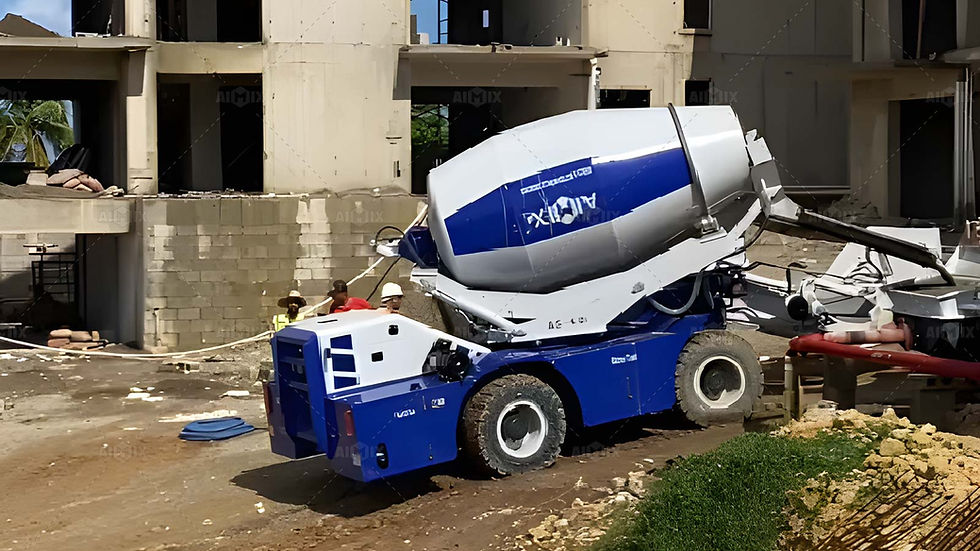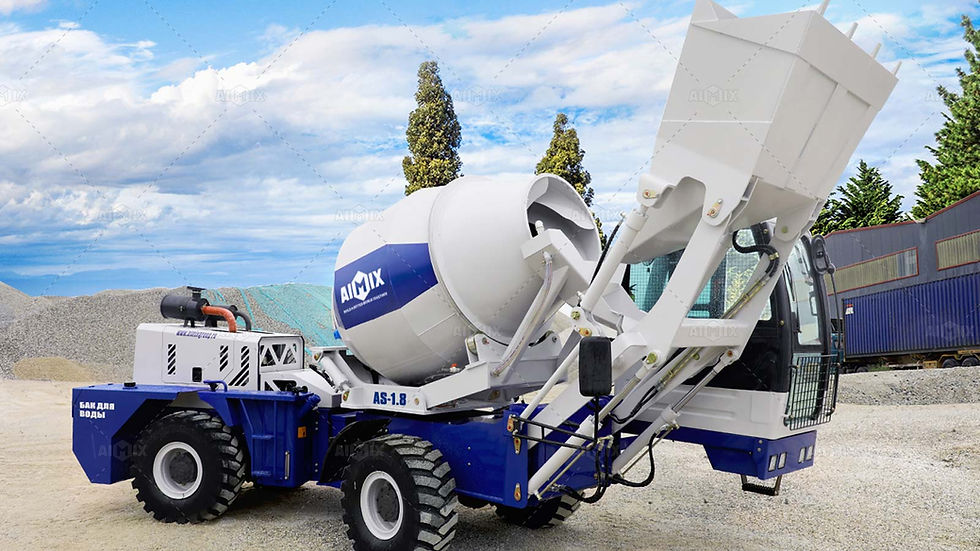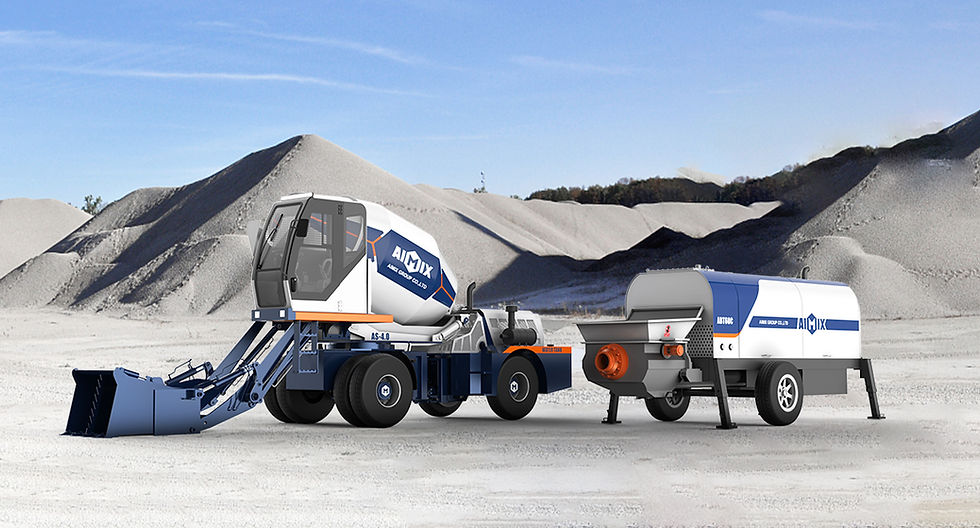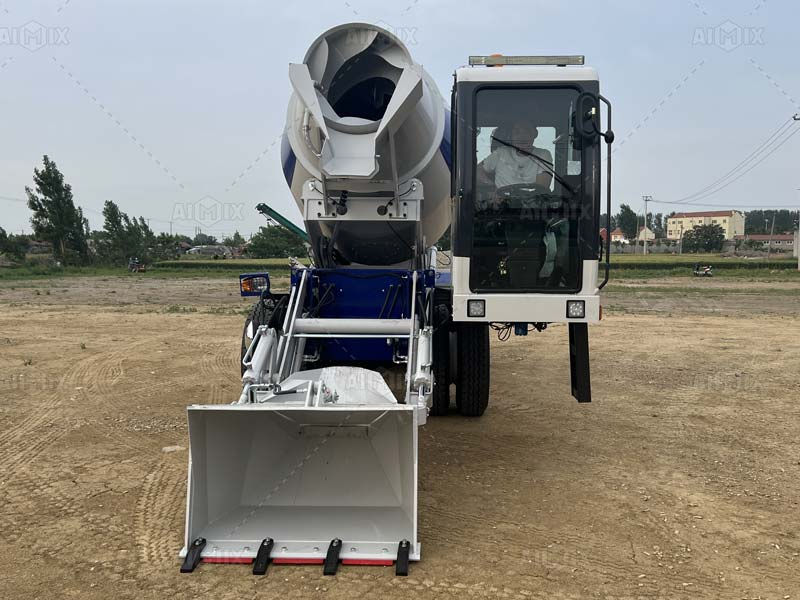How Do I Monitor the Concrete Quality Produced by a Self-Loading Mixer?
- aimixindonesia5
- Jun 30, 2024
- 3 min read
Concrete is the backbone of modern construction. Quality control in concrete production is paramount to ensure the structural integrity of any project. Self-loading mixers, such as the AIMIX models ranging from 1.2m³ to 6.5m³, have revolutionized the industry by providing on-site concrete production. However, monitoring the quality of concrete produced by these machines requires a systematic approach. Let's delve into the essential steps to ensure your self-loading mixer truck produces top-notch concrete.

Understanding Your Self-Loading Mixer
A self-loading concrete mixer is an all-in-one machine designed for concrete production and transportation. It combines the functions of a loader, mixer, and a transport truck. The versatility of these mixers makes them ideal for various construction projects. Knowing how to monitor the quality of concrete produced by these mixers is crucial for achieving optimal results.
Step 1: Selecting the Right Mix Design
Start with a proper mix design tailored to your specific project requirements. The mix design determines the proportions of cement, water, aggregates, and additives. Using the correct proportions ensures the desired strength, workability, and durability of the concrete. AIMIX self-loading mixers come with easy-to-use control panels that help you manage and adjust the mix design effectively.
Step 2: Calibrating the Self-Loading Mixer
Calibration is vital for ensuring accurate ingredient proportions. Before starting any batch, verify the calibration of the self loading mixer. Regular calibration checks help maintain consistency in the concrete mix, preventing deviations that could affect quality. Follow the manufacturer's guidelines for calibration to ensure the accuracy of the mixer beton self-loading system.
Step 3: Monitoring Water-Cement Ratio
The water-cement ratio significantly impacts the strength and durability of concrete. Too much water can weaken the mix, while too little can affect workability. AIMIX self-loading mixers allow precise control of the water input, ensuring the ideal ratio for your mix. Regularly monitor and adjust the water input to maintain the quality of your concrete.
Step 4: Ensuring Proper Mixing Time
Adequate mixing time is crucial for achieving a uniform concrete mix. Insufficient mixing can lead to weak spots and segregation. The self-loading concrete mixer comes equipped with advanced mixing technology to ensure thorough blending. Follow the recommended mixing times based on your mix design to achieve optimal consistency and quality.
Step 5: Conducting Regular Quality Tests
Regular testing is essential for quality control. Conduct slump tests to assess the workability of the concrete. Perform compression tests to evaluate the strength of the concrete produced by the self-loading mixer truck. Maintain a log of test results to monitor trends and identify any deviations from the expected quality.
Step 6: Inspecting Aggregate Quality
The quality of aggregates plays a crucial role in concrete production. Ensure that the aggregates are clean, well-graded, and free from contaminants. Self-loading mixers like AIMIX models are designed to handle a variety of aggregates. Regular inspections of the aggregate supply help maintain the overall quality of the concrete.
Step 7: Maintaining the Self-Loading Mixer
Regular maintenance of the self-loading mixer is crucial for consistent performance. Inspect the mixer’s components such as the drum, blades, and hydraulic system. Lubricate moving parts and replace worn-out components promptly. Proper maintenance minimizes downtime and ensures the mixer operates efficiently, producing high-quality concrete consistently.

The Benefits of Using AIMIX Self-Loading Mixers
AIMIX self-loading mixers offer several advantages for concrete production. Their models, ranging from 1.2m³ to 6.5m³, provide flexibility for different project sizes. The integrated mixing and loading functions save time and reduce labor costs. Additionally, the user-friendly controls allow for precise adjustments, ensuring consistent quality in every batch.
Real-Time Monitoring and Adjustments
Modern self-loading mixers come equipped with real-time monitoring systems. These systems provide data on the mix composition, temperature, and moisture levels. Operators can make on-the-fly adjustments to the mix, ensuring that the concrete meets the required specifications. This capability is invaluable for maintaining the quality of concrete throughout the production process.
Training and Best Practices
Investing in operator training is essential for maximizing the benefits of a self-loading mixer truck. Ensure that operators are familiar with the machine’s controls and maintenance procedures. Implementing best practices in operation and maintenance extends the lifespan of the mixer and enhances the quality of concrete produced.

Conclusion
Monitoring the quality of concrete produced by a self-loading mixer involves several key steps. From selecting the right mix design to conducting regular quality tests, each step is crucial for achieving high-quality concrete. AIMIX self-loading mixers offer the technology and flexibility needed for efficient and reliable concrete production. By following these guidelines, you can ensure that your self-loading mixer delivers consistent, high-quality concrete for all your construction projects. Get to understand the costs of self loading concrete mixers.



